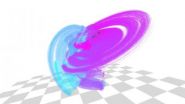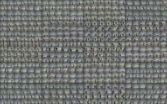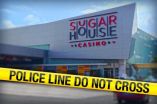(Press-News.org) PITTSBURGH—Carnegie Mellon University researchers have developed techniques for combining the views of 480 video cameras mounted in a two-story geodesic dome to perform large-scale 3D motion reconstruction, including volleyball games, the swirl of air currents and even a cascade of confetti.
Though the research was performed in a specialized, heavily instrumented video laboratory, Yaser Sheikh, an assistant research professor of robotics who led the research team, said the techniques might eventually be applied to large-scale reconstructions of sporting events or performances captured by hundreds of cameras wielded by spectators.
The video lab, called the Panoptic Studio, also can be used to capture the fine details of people interacting, whether it be college students casually conversing or a child being evaluated by a psychologist for signs of autism.
In contrast to most previous work, which typically has involved just 10 to 20 video feeds, the Carnegie Mellon researchers didn't have to worry about filling in gaps in data; their camera system can track 100,000 points at a time. Rather, they have to figure out how to choose which of the hundreds of video trajectories can see each of those points and select only those camera views for the reconstruction.
"At some point, extra camera views just become 'noise,'" said Hanbyul Joo, a Ph.D. student in the Robotics Institute. "To fully leverage hundreds of cameras, we need to figure out which cameras can see each target point at any given time."
The research team developed a technique for estimating visibility that uses motion as a cue. In contrast to motion capture systems that use balls or other markers, the researchers used established techniques for automatically identifying and tracking points based on appearance features — in this case, distinctive patterns. For each point, the system then seeks to determine which cameras see motion that is consistent with that point.
For instance, if a point on a person's chest is being tracked and most cameras show that point is moving to the right, a camera that picks up motion in the opposite direction is probably seeing a person or object that is in between the target and the camera. Or it may indicate the person has turned and the chest is no longer visible to the camera. In either case, the system knows that camera cannot see the target point and that its video feed is not useful for 3D reconstruction involving that point.
Other researchers have been able to use images from a large number of cameras, such as smartphones, to create 3D reconstructions of still images, Joo noted. But without methods such as the visibility estimation technique, 3D motion reconstruction at such a large scale has not been possible.
In the Panoptic Studio, the researchers have 480 video cameras, plus an additional 30 high-definition video cameras, arrayed all around and halfway up the walls of a geodesic dome that can easily accommodate 10 people.
Such a dense array of cameras enables the researchers to perform 3D motion reconstructions not previously possible. These include 3D reconstructions of a person tossing confetti into the air, with each piece of paper tracked until it reaches the floor. In another case, confetti is fed into a fan, enabling a motion capture of the air flow. "You couldn't put markers on the paper without changing the flow," Joo explained.
Likewise, such techniques might be used for reconstruction of the motion of animals, which typically can't be instrumented.
INFORMATION:
A video of the 3D reconstructions and links to the team's research paper are available on the project website, http://www.cs.cmu.edu/~hanbyulj/14/visibility.html.
The findings were presented at the Computer Vision and Pattern Recognition conference, June 24-27, in Columbus, Ohio. In addition to Sheikh and Joo, the research team included Hyun Soo Park, who this year completed his Ph.D. in mechanical engineering at CMU and is now a post-doctoral researcher at the University of Pennsylvania.
This research was supported by the National Science Foundation and a Samsung Scholarship.
The Robotics Institute is part of Carnegie Mellon's top-ranked School of Computer Science, which is celebrating its 25th year. Follow the school on Twitter @SCSatCMU.
About Carnegie Mellon University:
Carnegie Mellon is a private, internationally ranked research university with programs in areas ranging from science, technology and business, to public policy, the humanities and the arts. More than 12,000 students in the university's seven schools and colleges benefit from a small student-to-faculty ratio and an education characterized by its focus on creating and implementing solutions for real problems, interdisciplinary collaboration and innovation. A global university, Carnegie Mellon has campuses in Pittsburgh, Pa., California's Silicon Valley and Qatar, and programs in Africa, Asia, Australia, Europe and Mexico.
Carnegie Mellon combines hundreds of videos to reconstruct 3D motion without markers
With so many video feeds, choosing which to use is technical challenge
2014-07-17
ELSE PRESS RELEASES FROM THIS DATE:
Incidence of stroke in the elderly has dropped by 40 percent over the last 20 years
2014-07-17
Philadelphia, PA, July 17, 2014 – A new analysis of data from 1988-2008 has revealed a 40% decrease in the incidence of stroke in Medicare patients 65 years of age and older. This decline is greater than anticipated considering this population's risk factors for stroke, and applies to both ischemic and hemorrhagic strokes. Investigators also found death resulting from stroke declined during the same period. Their findings are published in the July issue of The American Journal of Medicine.
Preventable but deadly, stroke is the fourth leading cause of mortality in the ...
NYU Langone investigators to present new research at 2014 Alzheimer's Association International Conference
2014-07-17
(New York, NY, July 12, 2014) - Researchers from the Center for Cognitive Neurology (CCN) at NYU Langone Medical Center, NYU School of Medicine, and the Nathan S. Kline Research Institute will present new findings at the 2014 Alzheimer's Association International Conference in Copenhagen, Denmark, July 12 – 17, 2014.
The Center for Cognitive Neurology is a multidisciplinary, integrated center devoted to research, clinical care and clinical advances toward the treatment and cure of neurological diseases affecting cognition -- focused on memory, language, attention, auditory, ...
The rate at which groundwater reservoirs are being depleted is increasing
2014-07-17
FRANKFURT.In what parts of the world and to what degree have groundwater reservoirs been depleted over the past 50 years? The Frankfurt hydrologist Prof. Petra Döll has been researching this using the global water model WaterGAP. She has arrived at the most reliable estimate to date by taking into consideration processes which are important in dry regions of the world. The values calculated were compared with monitoring data from many different wells and data from the GRACE satellites. These satellites measure changes in the Earth's gravity field. Döll has come to the conclusion ...
What are the risks of post-traumatic stress disorder after an accident?
2014-07-17
This news release is available in French. Many patients continue to suffer from symptoms (headaches, pain) several months after an accident, which can pose a real handicap to their lives. The team of Emmanuel Lagarde, research director at Inserm's Research Centre for Epidemiology and Biostatistics (Inserm/University of Bordeaux) has studied the subsequent development of 1,300 people who were admitted to A&R between 2007 and 2009 for trauma. The researchers demonstrate that it is possible to identify people who will develop post-traumatic stress disorder, which generally ...
Danish DNA could be key to happiness
2014-07-17
Genetics could be the key to explaining nation's levels of happiness, according to research from the University of Warwick.
Economists at the University's Centre for Competitive Advantage in the Global Economy (CAGE) have looked at why certain countries top the world happiness rankings. In particular they have found the closer a nation is to the genetic makeup of Denmark, the happier that country is. The research could help to solve the puzzle of why a country like Denmark so regularly tops the world happiness rankings.
Dr Eugenio Proto and Professor Andrew Oswald ...
Potential new therapy with brain-on-a-chip axonal strain injury model
2014-07-17
University of Houston researchers have devised a new method for extracting molecules from live cells without disrupting cell development, work that could provide new avenues for the diagnosis of cancer and other diseases.
The researchers used magnetized carbon nanotubes to extract biomolecules from live cells, allowing them to retrieve molecular information without killing the individual cells. A description of the work appears this week in the Proceedings of the National Academy of Sciences.
Most current methods of identifying intracellular information result ...
Is the US National Flood Insurance Program affordable?
2014-07-17
There is often tension between setting insurance premiums that reflect risk and dealing with equity/affordability issues. The National Flood Insurance Program (NFIP) in the United States recently moved toward elimination of certain premium discounts, but this raised issues with respect to the affordability of coverage for homeowners in flood-prone areas. Ultimately, Congress reversed course and reinstated discounted rates for certain classes of policyholders.
Carolyn Kousky (Resources for the Future, USA) and Howard Kunreuther's (The Wharton School, University of Pennsylvania, ...
Plasmon-enhanced Polarization-selective filter
2014-07-17
As we all know, some optical devices can only work with a certain incident polarization direction. In this case, a polarizer is necessary to shift the polarization direction of linearly polarized light. A common polarizer is also called half-wave plate, which constructed out of a birefringent material (such as quartz or mica). The behaviour of a half-wave plate depends on the thickness of the crystal, the wavelength of light. Considering the fabrication of crystal, a half-wave plate is difficulty to integrate on circuits. Then what kind of polarizer can be integrated on ...
Do urban casinos increase local crime? Not in this case study
2014-07-17
Philadelphia's SugarHouse Casino opened its doors in September 2010 after years of protests from community members who feared that the casino would lead to an increase in neighborhood crime. However, a new study by researchers at Drexel University and Temple University reveals that these concerns were unfounded.
The study, which used geolocated crime data to examine changes in crime volume in the immediate neighborhood of the casino since its opening, found that crime rates in the Fishtown neighborhood of Philadelphia were largely unaffected by the introduction of the ...
University of Houston researchers create new method to draw molecules from live cells
2014-07-17
University of Houston researchers have devised a new method for extracting molecules from live cells without disrupting cell development, work that could provide new avenues for the diagnosis of cancer and other diseases.
The researchers used magnetized carbon nanotubes to extract biomolecules from live cells, allowing them to retrieve molecular information without killing the individual cells. A description of the work appears this week in the Proceedings of the National Academy of Sciences.
Most current methods of identifying intracellular information result ...
LAST 30 PRESS RELEASES:
Global psychiatry mourns Professor Dan Stein, visionary who transformed mental health science across Africa and beyond
KIST develops eco-friendly palladium recovery technology to safeguard resource security
Statins significantly reduce mortality risk for adults with diabetes, regardless of cardiovascular risk
Brain immune cells may drive more damage in females than males with Alzheimer’s
Evidence-based recommendations empower clinicians to manage epilepsy in pregnancy
Fungus turns bark beetles’ defenses against them
There are new antivirals being tested for herpesviruses. Scientists now know how they work
CDI scientist, colleagues author review of global burden of fungus Candida auris
How does stroke influence speech comprehension?
B cells transiently unlock their plasticity, risking lymphoma development
Advanced AI dodel predicts spoken language outcomes in deaf children after cochlear implants
Multimodal imaging-based cerebral blood flow prediction model development in simulated microgravity
Accelerated streaming subgraph matching framework is faster, more robust, and scalable
Gestational diabetes rose every year in the US since 2016
OHSU researchers find breast cancer drug boosts leukemia treatment
Fear and medical misinformation regarding risk of progression or recurrence among patients with breast cancer
Glucagonlike peptide-1 receptor agonists and asthma risk in adolescents with obesity
Reviving dormant immunity: Millimeter waves reprogram the immunosuppressive microenvironment to potentiate immunotherapy without obvious side effects
Safety decision-making for autonomous vehicles integrating passenger physiological states by fNIRS
Fires could emit more air pollution than previously estimated
A new way to map how cells choose their fate
Numbers in our sights affect how we perceive space
SIMJ announces global collaborative book project in commemoration of its 75th anniversary
Air pollution exposure and birth weight
Obstructive sleep apnea risk and mental health conditions among older adults
How talking slows eye movements behind the wheel
The Ceramic Society of Japan’s Oxoate Ceramics Research Association launches new international book project
Heart-brain connection: international study reveals the role of the vagus nerve in keeping the heart young
Researchers identify Rb1 as a predictive biomarker for a new therapeutic strategy in some breast cancers
Survey reveals ethical gaps slowing AI adoption in pediatric surgery
[Press-News.org] Carnegie Mellon combines hundreds of videos to reconstruct 3D motion without markersWith so many video feeds, choosing which to use is technical challenge





